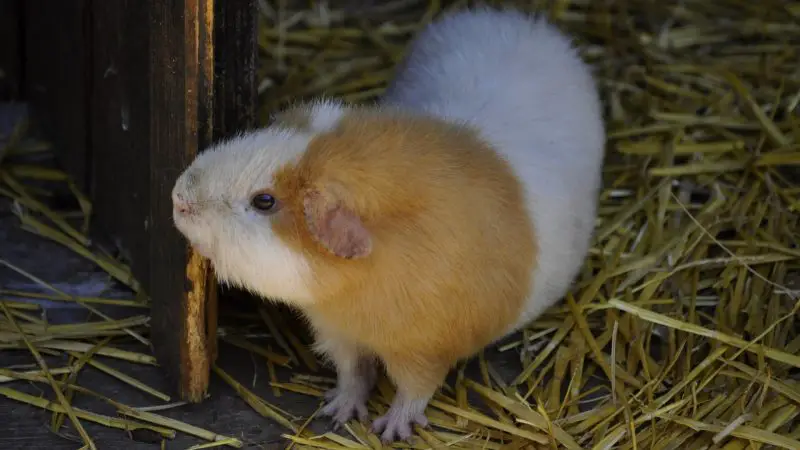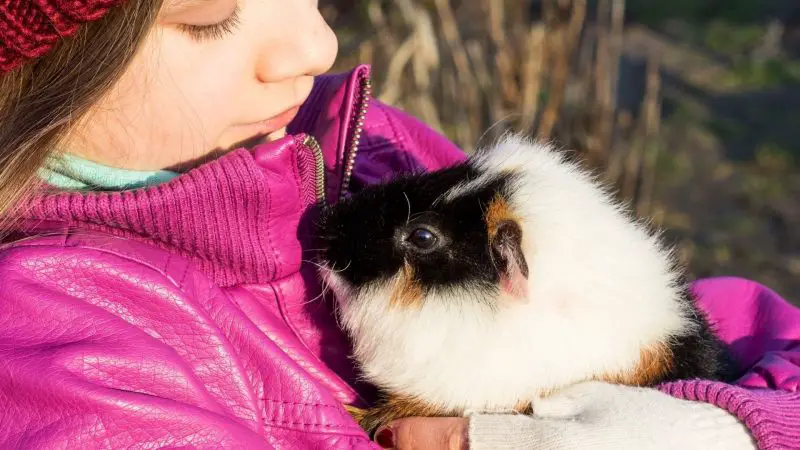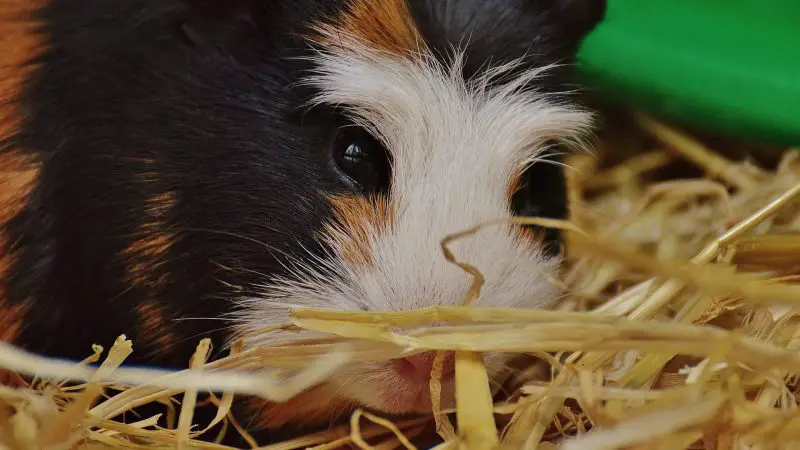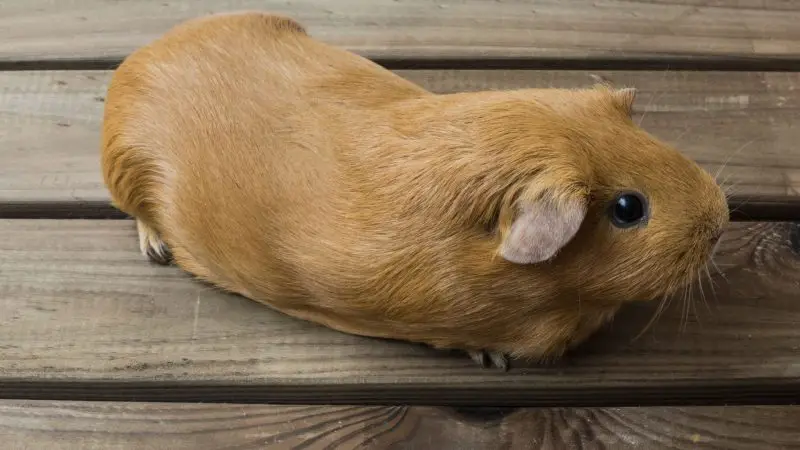You may already know that some types of guinea pigs can be found in the wild. If these little guys can spend the whole year living outside, then they surely can’t get cold, right?
The truth is that wild guinea pigs live in countries such as Argentina, Peru, Brazil, and Uruguay. What is the one thing these places have in common? A warm temperature almost all year round.
Can guinea pigs get cold, and can they live outside? Guinea pigs can get cold outdoors and even indoors at certain low temperatures. Additionally, they can live outside with a proper cage set-up and the necessary equipment to survive, especially in winter or cold weather.
This article will talk about what temperature suits guinea pigs and how you should prepare their cage if you are planning to keep them outside or somewhere cold. Let’s begin.
Table of Content
What Are the Normal Living Conditions for a Guinea Pig?

Before finding out how exactly you can help your guinea pig survive the winter, we have to determine what conditions are considered ‘normal’ for these cute creatures.
1. Cage With Proper Dimensions
The cage or wherever your guinea pig lives should be big enough. Your pet has to be able to stand up on its back legs without hitting the top of the cage. Moreover, there should be enough space for the guinea pig to play and run around. If you have more than one guinea pig, then the cage’s dimensions have to be bigger if you want to avoid any conflicts between the animals.
2. Create a Safe Place in the Cage
The cage has to have ‘a safe place.’ That’s usually a shelter where guinea pigs can hide if they feel nervous or stressed out. Certainly, the entire cage has to be well ventilated.
Make sure that everything inside the cage is dry. If the guinea pig trips over the water bowl by accident, remove the excess fluid as fast as possible. A dirty and damp environment is the perfect place for bacteria.
3. Adequate Cage Location
If your guinea pig is kept inside, you must ensure that the cage is not situated close to windows, radiators, or any heat sources. Also, if you have decided to place your guinea pig outside, put the cage away from direct sunlight and find a place that is not windy.
The place where you have decided to put your guinea pig’s cage has to be safe and as quiet as possible. Any type of noise can easily stress out these tiny creatures.
4. Temperature
Temperatures around 62°F to 68°F (17 to 20 degrees Celsius) are considered to be ideal for guinea pigs. However, temperatures a little higher or lower than these are tolerable. If it is below 15 degrees, the poor guinea pig can get chilled.
It is recommended to place the pet indoors once the temperature outside starts to fall below 59°F. High temperatures can also be dangerous. Guinea pigs can’t sweat. That means that temperatures above around 78 degrees Fahrenheit can easily cause heatstroke.
5. Fresh Food, Water, and a Clean Cage
Such things as fresh water, hay, and an overall clean environment in the cage, undoubtedly, go without saying.
Can Guinea Pigs Spend Winter Outside?

Guinea pigs can spend winter outside if there is no other possible choice. If their cage is fully equipped with all the necessary equipment that will be tackled in the next section, there shouldn’t be any problems.
How to Keep Guinea Pigs Warm Outdoors in a Cold Weather?
Keeping your guinea pig inside is always better once the temperature falls below 59°F (15 degrees Celsius). But there can be situations when it is simply impossible to move your pet indoors.
Don’t worry. Your guinea pig will be able to survive even during temperatures below zero, but there are a few things that you have to take care of:
1. Place the Cage in Another Building or a Place That Has a Cover
If there is such a possibility, place the cage in a shed or another building. In such a way, you will ensure that no wind or rain will affect the poor guinea pig.
2. Find a Location That Is Not Windy
As we have already mentioned above, your guinea pig’s cage has to be put in a not windy place. It can be behind your house, for example. Low temperatures are not that dangerous when the air is still.
3. Cover the Cage
Cover the top and the walls of the cage with a blanket, a carpet, or anything else that will help insulate the guinea pig’s home. Always make sure to leave a little space for ventilation. You can nail the blanket or carpet so that it doesn’t fall.
4. Raise the Cage Above the Ground
Do not put your pet on the ground. It doesn’t matter whether the cage is on grass or concrete. There has to be something between the ground and the guinea pig. Just hay is not enough. So think about placing another carpet or blanket on the cage floor.
5. Give Them More Hay When the Temperatures Are Low
Even in warm environments, guinea pigs need a lot of fresh hay daily. If the poor guinea pigs are exposed to low temperatures, they would need even more hay. Your pet has to have something that it can snuggle into. Adding a box full of hay is a great idea.
6. Pay Close Attention to the Water as It Can Freeze
The guinea pig’s water supply is the thing that would need the most of your attention. Animals need a constant supply of fresh and clean water. But during the winter months, water can freeze, which can become a big problem.
Make sure to check on the bowl or bottle at least a couple of times during the day. Add fresh water every time the old supply freezes. There are various bottle covers that you can buy to ensure that the liquid does not freeze.
7. Remove Anything Wet From the Cage Daily
Anything wet inside the cage can potentially be dangerous for the guinea pig’s health, especially during the colder months. You have to try to clean the damp place as fast as you can. Otherwise, the area can attract dangerous insects.
Moreover, if your guinea pig becomes wet as well, it can catch a cold. And the overall area can become dangerous after it freezes.
8. Snuggle Pads
There are such things as snuggle pads. Guinea pigs love them. You can place the heating pad into a microwave for a few seconds to make it warm. Then put the snuggle pad into the cage; it will help keep your guinea pig warm.
- Long-Lasting Warmth & Comfort – This pet heating pad provides up to 10 hours of consistent warmth, creating a cozy resting spot for pets of all ages, whether indoors, in kennels, or during chilly nights
- Microwave-Activated Thermapol Core – Filled with a heat-retaining Thermapol compound, this compact pet heat pad absorbs warmth efficiently in minutes and releases it gradually, making it an easy, hassle-free solution for added comfort
- Designed for Pets of All Ages – A great choice for young, recovering, or aging pets, this microwavable heat pad for pets can be used by veterinarians, breeders, and shelters to help animals stay comfortable in various living conditions
- Effortless & Low-Maintenance Care – No complicated cleaning required—simply wipe the dog heat pad with a damp cloth or mild cleaner to keep it fresh and ready for daily use, making upkeep quick and convenient
- Durable, Waterproof & Built to Last – Crafted with a sturdy, waterproof exterior, this cat heat pad is designed to withstand everyday use, making it a long-lasting essential for pet owners looking for a reliable source of warmth
This guide is suitable not only for outdoor pets. If it tends to get cold in your house, you can surely use the same tricks mentioned above to ensure that your guinea pig feels warm and cozy.
Related: Do Guinea Pigs Need Shots in Order to Stay Healthy
Here is a video on how to keep guinea pigs warm in winter and protect them from the cold:
How Do I Know if My Guinea Pig Is Cold?

Some signs will let you know your guinea pig is getting cold, such as shivering, huddling, or curling up their body and having cold ears. A freezing temperature might induce stress on your pet.
Can Guinea Pigs Get a Cold?

Guinea pigs can get a cold, but it certainly is a little different from the type of disease that humans tend to get.
A guinea pig can get either a bacterial or a viral respiratory infection, especially if it has been out in the cold for an extended period.
If your guinea pig is ill, it will stop moving, eating, and drinking. Moreover, it may have runny and red eyes, as well as a runny nose. In this case, you have to immediately see your vet if you have noticed that your guinea pig has these symptoms.
You can try to encourage your beloved pet to drink or eat something. To do this, put it in a place where the little one will feel safe and make sure to keep the other guinea pigs away from the sick guinea pig if you have more of them.
How Do Guinea Pigs Get Cold?
Here are some factors to affect your guinea pigs getting a cold:
Drop of Temperature
In the outdoors, a drop in temperature can increase the chance of your pet getting cold. On the other hand, an unproperly heating system indoors during winter can also affect your little pet. Below 15 degrees Celsius can make your guinea pigs chilled and catch a cold.
Changes in Humidity
Drastic changes in humidity can increase the chance of microbial growth such as bacteria and fungi inside and outside of your guinea pigs’ cage. Some of these microorganisms can cause respiratory illness or weaken your pets’ immune system, susceptible to other diseases.
Unbalanced Diet
Guinea pigs needed a well-balanced diet to be healthy and to keep away from diseases. Vitamin C-rich foods cannot cure common colds, but they can prevent serious health complications for your pets.
Lack of this vitamin can lead to scurvy disease and weaken the immune system, making them at risk of having a cold.
Contrarily, feeding them a little extra such as hay can help during the winter months. It will serve as extra fat insulation that can help their body warm. However, ensure and monitor their diet, as excessive food consumption can be detrimental to their health.
Lack of Hygiene
A dry and clean cage is essential not to attract any bacteria that can cause respiratory illness to your pet.
Clean any damp areas inside the cage, and ensure that your pet is always dry, as sometimes they get wet from tipping off their water bowl and can eventually catch a cold.
Do Guinea Pigs Need Exercise During Winter?

Guinea pigs are somewhat active by socializing with the pet owner or other guinea pigs by moving and running around. These activities can help their body warm, especially during the winter months.
Without enough space, it can prevent them from doing these activities, which can lead to some health issues such as obesity.
Related: Can Guinea Pigs Catch Human Colds or Any Other Human Disease?
Guinea pigs are incredible but very vulnerable and gentle creatures. They can easily get stressed out even about the smallest changes in their environment. But guinea pigs are tender animals, not only in the psychological but also in the physical aspect.
Direct sunlight, wind, and drastic temperature changes can make your guinea pig ill.
At the same time, guinea pigs will be able to handle low temperatures if there is such a need. These tiny creatures are simultaneously vulnerable and strong, tender and hardy. And, maybe, that’s the reason why we love guinea pigs so much.
Related: Do Guinea Pigs Need Vaccinations?

